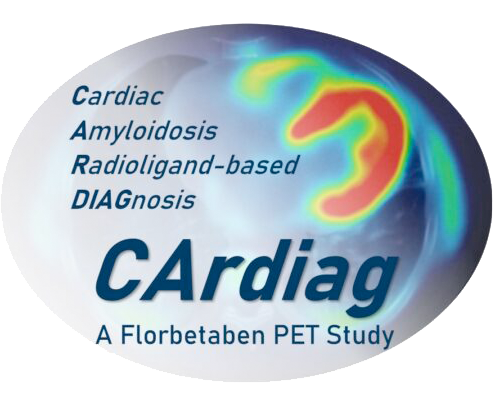CArdiag Phase 3 study
| Study title | An open-label, multi-center, non-randomized pivotal Phase 3 study to evaluate the efficacy and safety of [18F]florbetaben Positron Emission Tomography (PET) imaging to diagnose cardiac AL amyloidosis |
| Study identifier | NCT05184088 |
| Number of patients to be enrolled | 200 |
| Trial status | Recruiting |
| Condition | Cardiac amyloidosis |
| Study start | January 2023 |
Primary Endpoint
The co-primary efficacy variables will be the sensitivity and specificity of the visual assessment of [18F]florbetaben PET images for the diagnosis of cardiac AL amyloidosis. The visual assessment results are compared to the clinical diagnosis established through histological verification of the presence or absence of AL amyloidosis with cardiac involvement determined either through endomyocardial biopsy or through extracardiac biopsy in conjunction with typical CMR or echocardiographic imaging features as the standard of truth.

Secondary/exploratory endpoints
Secondary endpoints
- The sensitivity and specificity of [18F]florbetaben PET for the diagnosis of cardiac AL amyloidosis will be determined by using quantitative image analysis
- Correlation of quantitative [18F]florbetaben PET results with left ventricular ejection fraction (LV EF) and left ventricular mass (LV mass)
- Correlation of quantitative [18F]florbetaben PET results with AL-CA prognostic values (Mayo stage I – IV) based on FLC-diff, cTnT and NT-proBNP levels
- The impact of PET imaging (AL-CA/non AL-CA) on diagnostic thinking and patient management will be assessed with physician’s questionnaires before and after the diagnostic work-up, and after receipt of the PET results
Exploratory endpoints
- The ability of [18F]florbetaben PET imaging to differentiate between AL CA, ATTR CA, and non CA will be assessed
Patient eligibility
Patients with suspected cardiac amyloidosis or with a putative diagnosis of cardiac amyloidosis but with remaining diagnostic uncertainty (e.g. unclear etiology and/or cardiac manifestation) or patients with diagnosis of amyloidosis but unclear cardiac involvement will be recruited for the study.
Study-specific Inclusion Criteria
- Subjects being considered for a possible diagnosis of cardiac amyloidosis by:
- One of the following conditions:
- Established systemic amyloidosis without proven cardiac involvement
- Known plasma cell dyscrasia (MGUS, multiple myeloma)
- Pathological free light chain levels in urine or serum
- Presence of heart failure with preserved ejection fraction
- AND one of the following parameters, indicative of cardiac manifestation:
- Mean (left ventricular (LV) wall + septum) thickness >12mm as measured by echocardiography in absence of other known cause of left ventricular hypertrophy (LVH)
- NT-proBNP >335 ng/L
- Planned diagnostic procedures to establish diagnosis and cardiac involvement (e.g., endomyocardial biopsy or extracardiac biopsy in conjunction with cardiac magnetic resonance imaging/ echocardiography or bone scintigraphy)
Exclusion Criteria
- Any known allergic reactions or hypersensitivity towards any compound of the study drug
- Severe hepatic impairment (AST/ALT >5 x ULN; bilirubin >3 x ULN )
- Inability to lay flat for up to 60 min
- Pregnant, lactating or breastfeeding
- Unwilling and/or unable to cooperate with study procedures
- Having been administered a PET radiopharmaceutical within 10 radioactive half-lives prior to study drug administration in this study
[18F]florbetaben PET scan procedure
For [18F]florbetaben PET imaging session, a venous catheter will be placed for the intravenous (i.v.) administration of the radioligand. Subjects will receive a slow i.v. bolus injection (6 sec/ml) of 300 MBq ± 20 % (240-360 MBq) of [18F]florbetaben.
Dynamic PET acquisition of the thorax (heart in FOV) will be performed from 0 to 45 min post-injection (p.i.). Whole body scanning will be performed from 45 to approx. 60 min p.i. starting from the base of the skull to the mid-thighs (2-3 min per bed position).


